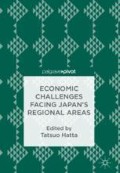Abstract
Japan’s fishing industry faces two problems: a decline in overall production and catches of key species, and a decline in the number of fishing industry workers and general aging of the population. These problems represent a threat to the sustainability of Hokkaido’s fishing industry, the cornerstone of Japan’s fishing industry, and of Hokkaido’s coastal and offshore island communities. Focusing on Hokkaido’s Rishiri and Rebun Islands, this chapter considers legislative and policy perspectives relating to the problem of declining catches. The chapter suggests that the enhancement of fisheries resource management beyond existing voluntary measures, based on scientific data and with respect for the experiences of fishing communities, may be the key to promoting sustainable fisheries and ensuring the survival of the local communities that rely on them.
Access this chapter
Tax calculation will be finalised at checkout
Purchases are for personal use only
Notes
- 1.
The “sextiary” industry, or the “sextiary” sector (sometimes called the “sixth sector,”) is a Japanese term referring to the diversification of agriculture into agriculture-related manufacturing and services such as food processing and restaurant management. The concept of a “sixth sector” originates from the idea of combining agricultural production (Primary industry: 1) with processing (Secondary industry: 2) and distribution and sales (Tertiary industry: 3) to generate a synergistic relationship (1 × 2 × 3 = 6).
References
Community Development Department, Rishiri Town (2016), “Hesei27nen Gyogyo Seisan Jokyo Shiryo (Documents Relating to Status of Fisheries Production, 2015),” January, 2016 (In Japanese).
Expert Panel on the TAC System, Etc. (2008), “TAC-Seido no Kadai to Kaizenhoko (Chukan Torimatome) (Issues of the TAC System and Directions for Improvements (Interim Report)),” September 2008 (In Japanese).
Fisheries Ports Administrator, Rishirifuji Town (2016), “Hesei28nendoban Rishirifuji-cho no Suisan (Rishirifuji Fisheries, FY2016 Edition),” April 2016 (In Japanese).
Hokkaido Government, Administration Department, Fisheries and Forestry Division (ed.) (2016), Hokkaido Suisangyo/Gyoson no Sugata 2016 –Hokkaido Suisan Hakusho (Hokkaido Fisheries White Paper: State of Hokkaido’s Fishing Industry and Fishing Villages, 2016), June 2016, Hokkaido Government (In Japanese).
Hokkaido Government, Fisheries Management Section, Fisheries Bureau, Fisheries and Forestry Division (ed.) (2015), “Hokkaido Suisanshigen Kanri Manyuaru 2015nendoban (Manual for Management of Fishery Resources in Hokkaido, FY2015 Edition),” Hokkaido Government, and Fisheries Research Department, Hokkaido Research Organization (In Japanese).
Hokkaido Government, Soya General Subprefectural Bureau, Fisheries Section, Regional Development Department (ed.) (2015), Soya no Suisan Heisei 25nendoban (Soya Fisheries, FY2013 Edition), Hokkaido Government Soya General Subprefectural Bureau, October 2015 (In Japanese).
Rebun Town (2016), “Gyoshubetsu Gyokakudaka no Suii (Trends in Fishery Yields, by Species),” February 2016 (In Japanese).
Acknowledgments
The author wishes to express her sincere gratitude to all the individuals concerned at the Center for Research and Promotion of Japanese Islands, the Rishirifuji, Rishiri, and Rebun Town administrations, the Rishiri Island History Museum, the Rishiri Town Museum, the Rebun Town Historical Museum, the Rishiri Fisheries Cooperative Association, the Kafuka Fisheries Cooperative Association, Jinpo Foods (a marine products processing company), the Hokkaido Federation of Fisheries Cooperative Associations, and the Fisheries Section of the Industry Promotion Department, Soya Regional Development Bureau for their assistance in onsite surveys on Rishiri and Rebun Islands, the provision of relevant data and materials, and the checking of information regarding relevant laws during the writing of this chapter.
This chapter presents part of the outcome of research conducted with the assistance of a Japan Society for the Promotion of Science (JSPS) Grant-in-Aid for Scientific Research and a Mitsubishi Foundation Research Grant in the Humanities (16H03570).
Author information
Authors and Affiliations
Editor information
Editors and Affiliations
Rights and permissions
Copyright information
© 2018 The Author(s)
About this chapter
Cite this chapter
Koyano, M. (2018). Revitalization of Japan’s Fishing Industry: A Legal Perspective—The Cases of Rishiri and Rebun Islands. In: Hatta, T. (eds) Economic Challenges Facing Japan’s Regional Areas. Palgrave Pivot, Singapore. https://doi.org/10.1007/978-981-10-7110-2_6
Download citation
DOI: https://doi.org/10.1007/978-981-10-7110-2_6
Published:
Publisher Name: Palgrave Pivot, Singapore
Print ISBN: 978-981-10-7109-6
Online ISBN: 978-981-10-7110-2
eBook Packages: Economics and FinanceEconomics and Finance (R0)

